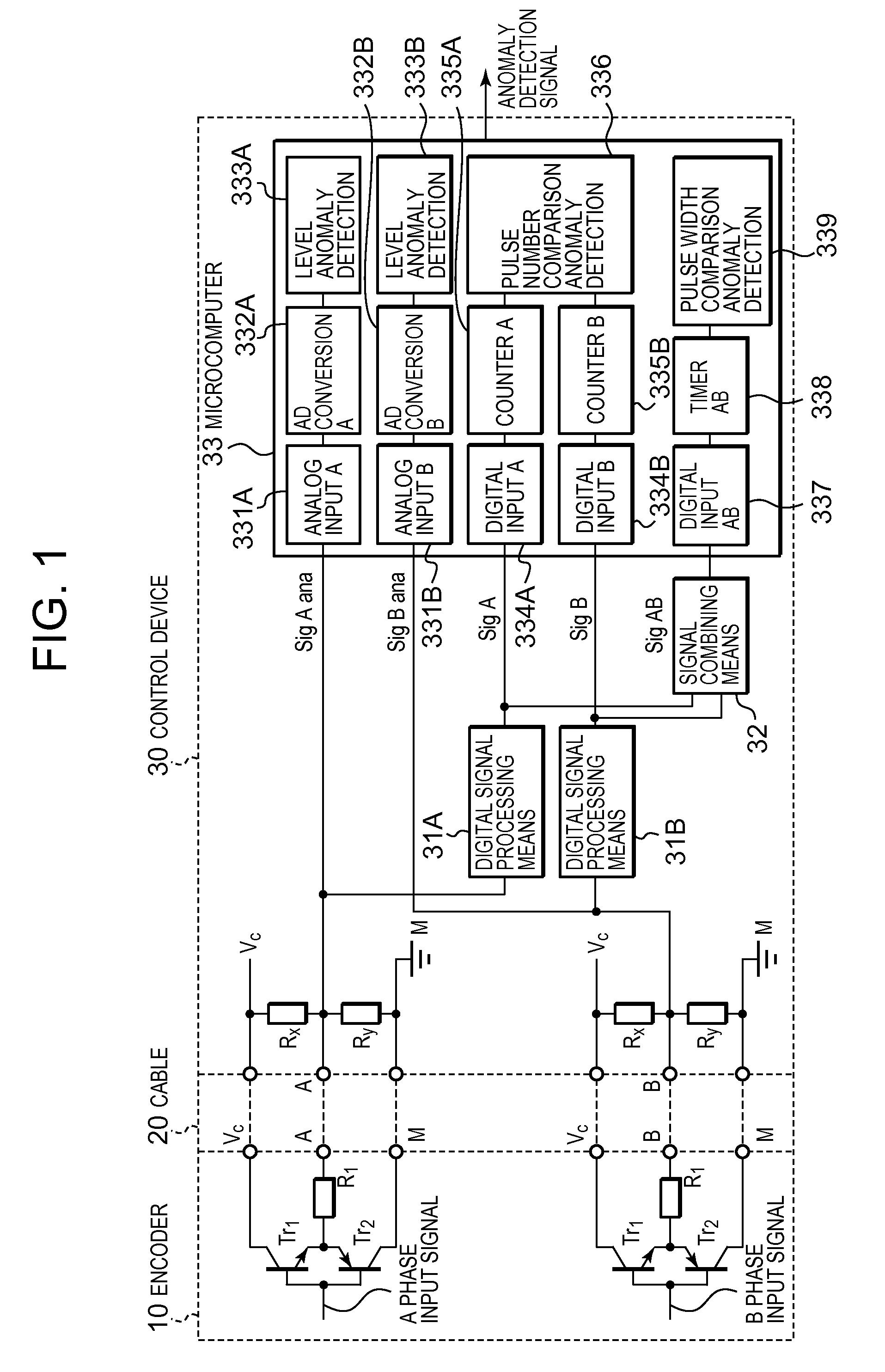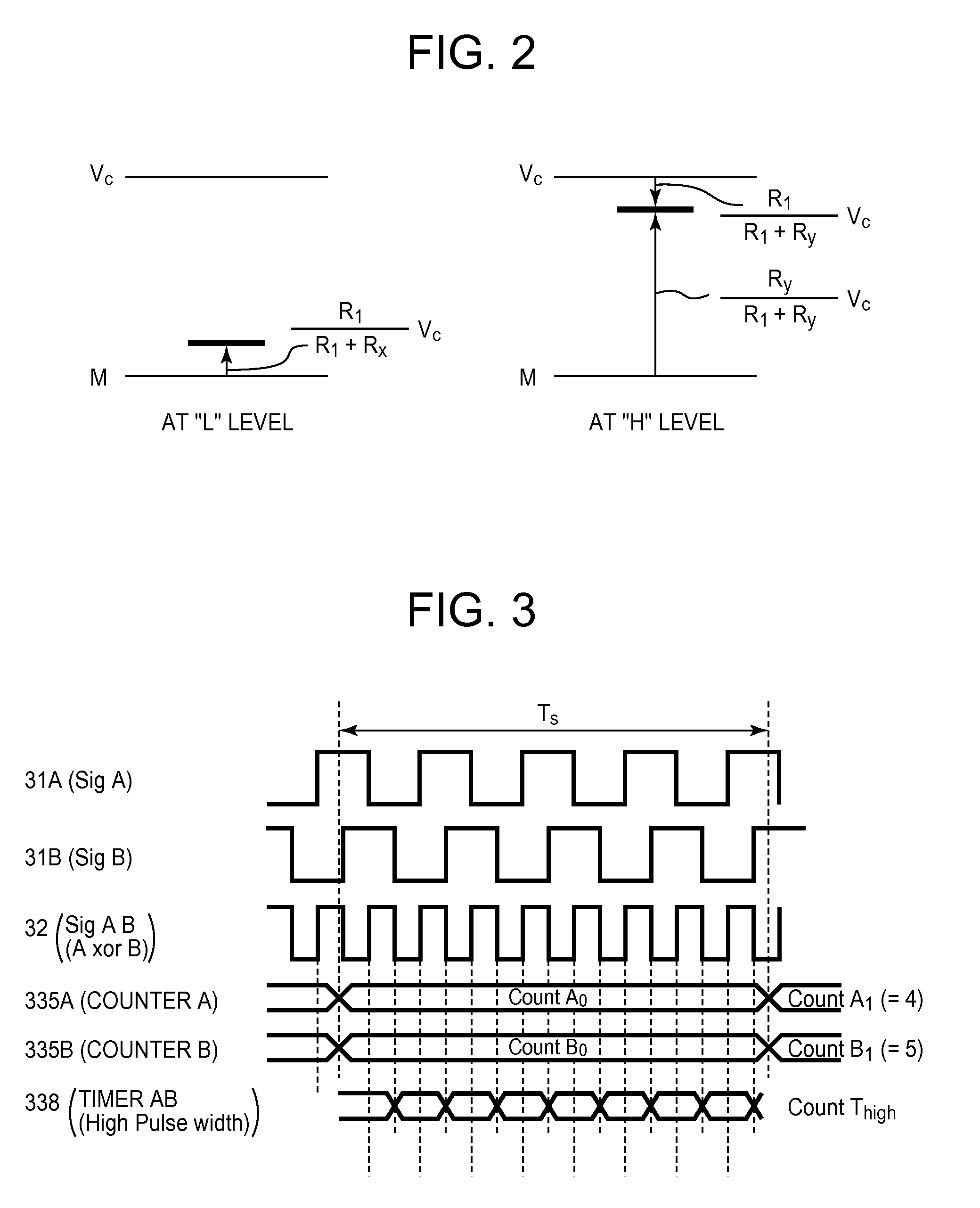Anomaly monitoring device
a monitoring device and anomaly technology, applied in the direction of measurement devices, electrical testing, instruments, etc., can solve the problems of difficult wiring anomaly judgment, erroneous detection of anomalies, and difficulty in estimating the number of pulses for each phase, so as to improve the accuracy of anomaly detection and increase the space or cost of the devi
- Summary
- Abstract
- Description
- Claims
- Application Information
AI Technical Summary
Benefits of technology
Problems solved by technology
Method used
Image
Examples
first embodiment
[0088]FIG. 1 is a circuit diagram showing the invention. In FIG. 1, 10 is an encoder which outputs analog signals with two phases, different by 90°; is a cable, including power supply lines, signal lines, and ground lines; and 30 is a control device which processes output signals of the encoder 10 and detects anomalies of the encoder 10 anomalies of the wiring system including the cable 20.
[0089]The encoder 10 includes an optical sensor which generates two relative position detection signals (A phase signals and B phase signals) with phase differing by 90°. The rotation member and the optical sensor are omitted from the drawing.
[0090]The A phase signals and B phase signals are respectively input to the bases of transistors Tr1, Tr2 with a complementary configuration. Here, the processing circuits for A phase signals and for B phase signals have the same configuration, and in addition to the complementary configuration of this embodiment, a complementary configuration such as that of...
third embodiment
[0150]Next, FIG. 10 is a circuit diagram showing the invention.
[0151]In the above-described first and second embodiments, when the pulse width comparison anomaly detection portion 339 detects anomalies based on a timer value (pulse width), the signal combining device 32 must combine the A phase and B phase digital signals SigA, SigB, with different phases, to create the combined signal SigAB. However, as is clear from FIG. 3 and elsewhere, the “H” level pulse width of the combined signal SigAB is ½ the “H” level pulse widths of the original digital signals SigA and SigB. Hence when the rotation member rotates rapidly, the “H” level pulse width of the combined signal SigAB becomes short, and due to constraints on the microcomputer clock resolution, if the pulse width becomes shorter than the time intervals measured by the timer, measurement becomes impossible. In addition, in the first and second embodiments it is not possible to create the combined signal within the microcomputer, a...
second embodiment
[0174]The position for dual configuration of the two microcomputers 311X, 311Y, and the mode of communication between the microcomputers 311X, 311Y, can be selected arbitrarily, similarly to FIG. 9.
[0175]In this embodiment also, the data comparison devices 313X, 313Y compare data received by the communication devices 312X, 312Y from the other microcomputer with their own anomaly detection results, with the voltage levels of analog signals, with the number of pulses of digital signals, and with pulse widths. And, when there are differences between these data, and when the differences between the voltage levels, numbers of pulses, and pulse widths exceed prescribed threshold values, an anomaly detection signal 1 or anomaly detection signal 2 is output. By this means, the functions of the microcomputers 311X, 311Y can be diagnosed.
[0176]Here, the anomaly detection signal 1 and anomaly detection signal 2 may include the anomaly detection results of the level anomaly detection itself, of...
PUM
 Login to View More
Login to View More Abstract
Description
Claims
Application Information
 Login to View More
Login to View More - R&D
- Intellectual Property
- Life Sciences
- Materials
- Tech Scout
- Unparalleled Data Quality
- Higher Quality Content
- 60% Fewer Hallucinations
Browse by: Latest US Patents, China's latest patents, Technical Efficacy Thesaurus, Application Domain, Technology Topic, Popular Technical Reports.
© 2025 PatSnap. All rights reserved.Legal|Privacy policy|Modern Slavery Act Transparency Statement|Sitemap|About US| Contact US: help@patsnap.com



